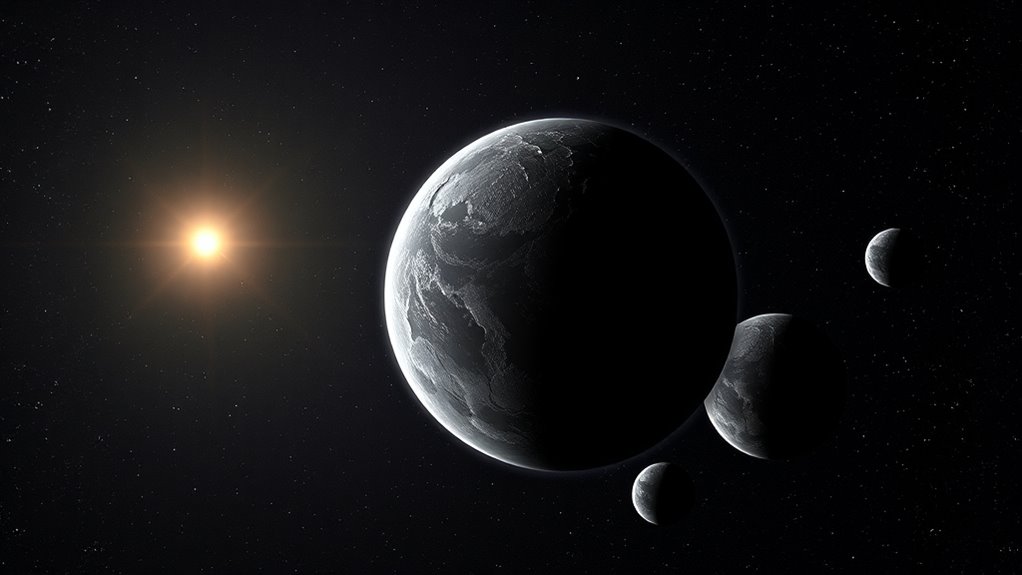The James Webb Space Telescope is now targeting exomoons orbiting distant planets to study their atmospheres for signs of habitability and potential life. You can expect Webb’s advanced instruments to detect molecules like water vapor, oxygen, and methane, which suggest conditions suitable for life. These discoveries could reveal environments similar to Europa or Enceladus. If you’re curious about how Webb’s findings might reshape our understanding of life beyond Earth, keep exploring further.
Key Takeaways
- Webb aims to detect atmospheres of exomoons, analyzing their composition for signs of habitability.
- Focuses on identifying water vapor, oxygen, and methane, which suggest potential for supporting life.
- Uses infrared capabilities to detect atmospheric signatures and assess environmental conditions.
- Targets include moons orbiting exoplanets in habitable zones, where liquid water might exist.
- Findings will prioritize promising worlds for future exploration in the search for extraterrestrial life.

After successfully capturing stunning images of distant galaxies and exoplanets, the James Webb Space Telescope is now turning its gaze toward a new set of targets. These are exomoons—moons orbiting planets outside our solar system—that could potentially harbor life. With its advanced instruments, Webb aims to study these elusive worlds in unprecedented detail, focusing on their exoplanet atmospheres and evaluating their habitability potential.
Exomoons are intriguing because they may possess environments suitable for life, much like some moons in our solar system, such as Europa or Enceladus. To determine if these moons could sustain life, you’ll need to analyze their exoplanet atmospheres carefully. Webb’s infrared capabilities allow you to detect atmospheric composition, searching for signs of water vapor, oxygen, methane, or other molecules that suggest a hospitable environment.
By examining the atmospheric signatures, you can evaluate whether these moons have the right conditions for life or if they possess protective atmospheres that could shield potential biospheres from harmful radiation. Habitability evaluations involve more than just spotting water or oxygen. You’ll evaluate the temperature ranges, the presence of greenhouse gases, and the stability of these atmospheres over time.
Webb’s ability to analyze exoplanet atmospheres helps you understand the energy balance and climate conditions on these moons. If you find atmospheres rich in volatiles and capable of maintaining liquid water, it boosts the chances that these worlds might host life forms, even if they’re small or orbiting distant planets.
Your observations could reveal atmospheric features that hint at geological or biological activity, like volcanic gases or organic molecules. Such discoveries would be groundbreaking, expanding the scope of where life might exist beyond Earth. The challenge lies in distinguishing between atmospheric signals caused by natural processes and those indicative of biological activity, but Webb’s sensitivity gives you a fighting chance to make these distinctions.
Furthermore, understanding the high contrast ratio of these atmospheres is crucial because it affects how well you can detect faint signals from potential biosignatures against the background noise. Ultimately, your goal with these targets is to narrow down the most promising worlds for future exploration. By piecing together data on exoplanet atmospheres and conducting thorough habitability evaluations, you help identify exomoons that could be oases of life in the vastness of space. This work not only deepens our understanding of planetary systems but also brings us closer to answering one of humanity’s most profound questions: Are we alone in the universe?
Frequently Asked Questions
How Will JWST Differentiate Between Exomoons and Planets?
You’ll find that JWST differentiates exomoons from planets by overcoming detection challenges through advanced observational techniques. It analyzes subtle variations in light curves during transits, noticing differences in size and orbital patterns.
JWST’s sensitive instruments help distinguish the smaller, often irregular signals of exomoons from larger planets, allowing you to identify these celestial bodies more accurately. These methods give you clearer insights into their unique characteristics and potential habitability.
What Specific Signs of Habitability Will JWST Look for in Exomoons?
Imagine peering through a cosmic window, searching for signs of life. JWST looks for habitability indicators like water vapor, methane, or oxygen in exomoon atmospheres—clues that suggest potential life-supporting environments.
It analyzes atmospheric composition to detect these markers, revealing if an exomoon might be a new home for life. These signals could uncover the secrets of distant worlds and ignite your curiosity about the universe’s possibilities.
How Many Exomoons Are Expected to Be Observable With JWST?
You might wonder about the number of exomoons observable with JWST, considering exomoon statistics and observation challenges. While exact figures are uncertain, scientists estimate JWST could detect dozens of exomoons, especially large ones around nearby planets.
Observation challenges include faint signals and stellar interference, but JWST’s advanced instruments will improve detection chances. Ultimately, it’s a promising step toward understanding potential habitable worlds beyond our solar system.
Will JWST Help Identify Biosignatures on Exomoons?
Think of biosignature detection as searching for a cosmic fingerprint—it’s complex but revealing. With the JWST, you’ll have the tools to analyze atmospheric composition on distant exomoons, increasing your chances of spotting signs of life.
While it mightn’t confirm life directly, the telescope’s sensitivity could uncover telltale atmospheric clues that suggest habitability, bringing you closer to answering one of humanity’s most profound questions: Are we alone?
How Does Jwst’s Technology Improve Exomoon Detection Compared to Previous Telescopes?
You’ll find that JWST’s advanced technology greatly improves exomoon detection through stellar spectroscopy and atmospheric characterization.
Unlike previous telescopes, it captures detailed spectra, revealing atmospheric compositions even from distant exomoons.
Its infrared capabilities allow you to detect biosignatures and atmospheric gases that hint at habitability.
This precision enables you to identify potential life-supporting environments more effectively than before, opening new frontiers in exoplanet research.
Conclusion
As you watch the James Webb Telescope explore exomoons, remember you’re witnessing the pursuit of discovery, the quest for life, and the hope for understanding. With every observation, you get closer to unraveling mysteries, to expanding knowledge, to inspiring wonder. The journey isn’t just about finding new worlds; it’s about fueling curiosity, igniting imagination, and shaping the future of exploration. As you follow this mission, you’re part of something extraordinary, something that could redefine our place in the universe.










